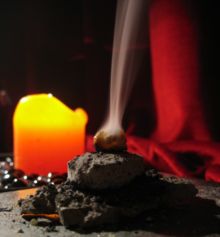Capnomancy
The Kapnomantie is the divination of the of fire rising smoke . From this smoke that forms multiple shapes and figures in the air, the future is to be predicted. This ceremonial mantic magic is one of the eight genera of hydromance and is traced back to the four basic elements .
History and practices
In the 1st century Publius Papinius Statius, in his epic Thebais, commemorated the prophecies of smoke and mentioned the different circles and forms of smoke, there it says:
“At the altars, O virgin, let us consult the gods!
And then she looks at the fire with a shrewd eye;
how the reddish tips of the flames flare up to heaven;
in the middle, however, it burns with a serene glow;
Then the tan turns like a snake in a circle, etc. "
At the time of the Bosporan Empire , i.e. in the 5th century, smoke reading was a widespread art of fortune telling, it was passed down from generation to generation. The traditional practice was to sprinkle plant seeds - mostly poppy or jasmine and partly incense resin - on one or more pieces of glowing charcoal . The smoke that developed and rose from it, which served as an oracle , supported the interpretations and the divinations that followed from them.
The doctor , philosopher and mathematician Gerolamo Cardano wrote about capnomanty that the capnomancers used poppy seeds or sesame seeds as smoke generators. A young boy or a pregnant woman, who now recognized and described the various smoke figures, were brought in to interpret the smoke signals.
Also, the polymath Agrippa of Nettesheim , mentioned in his work De acculta philosophia (1531), the Kapnomantie as fortune-telling from the smoke.
Interpretations
If the smoke rose evenly and straight into the air, it was considered a sign of a prosperous future. Leaning smoke meant bad luck and smoke spreading in different directions was a sign of an uncertain future. Further interpretations were used for smoke movements in the different four directions . From the fictitious figures formed by the smoke, interpretations were also derived from certain symbols and images.
literature
- Georg Pictorius: Of the genres of ceremonial magic that are called Goëtie. In: Kurt Benesch: Magic of the Renaissance. Fourier Verlag, Wiesbaden 1985, ISBN 3-921695-91-0 .
- Ulrike Müller-Kaspar (Ed.): The great handbook of superstition, from eel to cypress. tosa published by Ueberreuter Verlag , Vienna 2007.
Web links
- Agrippa von Nettesheim: The magical works: and further Renaissance treatises. Edited and introduced by Marco Frenschkowski . Marix Verlag , 2013, ISBN 978-3-8438-0158-4 .
Individual evidence
- ↑ Elias Caspar Reichard : Mixed contributions to convey a closer insight into the entire spirit realm. Volume 1, 1781. ( books.google.de , accessed July 3, 2016)
- ^ A b c Agrippa von Nettesheim: The magical works: and further Renaissance treatises. In: Elias Caspar Reichard : Mixed contributions to convey a closer insight into the whole spirit realm. Volume 1, 1781, chap. 11. (books.google.de)
- ↑ Leander Petzoldt : Magic: worldview, practices, rituals. (= Beck series. Volume 6015). Verlag CH Beck, 2011, ISBN 978-3-406-62151-2 . (books.google.de)
